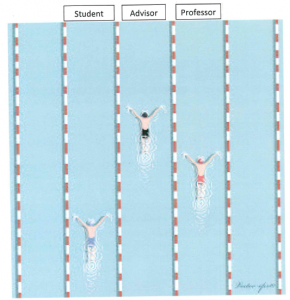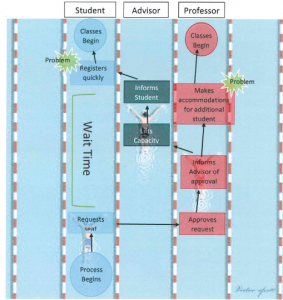With the Rio 2016 Summer Olympics among us and being proud Americans, you probably can’t even go to the grocery store without something or someone blaring “USA! USA! USA!” amid chanting crowds. Can you blame us? We’re up to 83 medals in two weeks, and Hello! Katie Ledecky! Breaking a world record while winning a gold medal by *cough* ONLY 11.38 seconds! That’s pretty cool and yes, GO USA! However, moving passed the idea of the stripes and stars, I’m more interested in the arena Katie took her gold in, and that was in a swimming pool-the kind with swim lanes.
Swim lanes are a tool that is depicted through a diagram. How this tool works is to show the flow of a process or the crossing of many areas of a process and doing so visually. To aid in understanding the steps, an example represented by the progression of the tool will be shown below with a description of each step. This example shows a student who needs to get into a class that has already reached it’s maximum capacity and can’t register for it so they request an exception.
How a swim lane is kicked off is through identifying who touches the process. This “who” can be an individual, a group, a department, an object, or basically anything that physically touches the process. For our example, the who’s include the student, academic advisor of the student, and the professor of the class being registered.
Once the “who’s” are identified, the what’s need to be added. These “what’s” are the current processes that each “who” goes through and how each others processes relate to one another. This is also where you identify where each “who’s” process starts. The process for our example starts with the student and moves to the professor then to the advisor and back to the student.
The third step is where the “what” is examined and analyzed for where there is waste within the process or steps and that don’t add value. For our diagram, there is a waste of time between the time the student makes the request and actually hears back that they can register. This is a waste because it is waiting time. There is also waste for the student: once they are able to register they have to do it very quickly so that another student doesn’t register when they see an open or an “extra” seat. There’s also waste for the professor: they need to do re-work of their classroom to be able to accommodate an additional student.
Through the use of swim lanes you are made to focus on the basic steps to figure out what is actually happening in a process, and once that is done, you are able to then dive into the process and figure out where the defected or problematic areas are and can then get to the root cause. This aids you in being able to see the big picture. Often times we have a process that is “broken” and we become frustrated and redo the entire process just to find that it didn’t reduce the frustration. However, through the use of swim lanes you are able to see the whole process and establish what part(s) of the process is/are broken and can devote your time and energy into making improvements to that specific area without redoing the whole thing. So just like Katie Ledecky, if we take one [free-style] stroke at a time, we can come out in record time.


